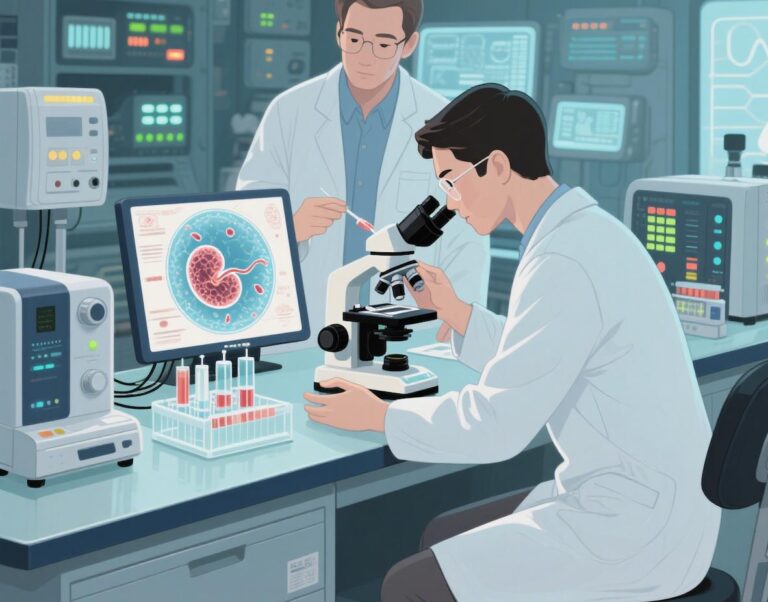Breaking through the dual challenges of endometrial thickness and quality in surrogate mothers

I. Endometrial Thickness: The Basis, But Not The Only Key Indicator
In assisted reproduction technology, surrogate mother endometrial thickness is often regarded as the “gold standard” for embryo implantation. Studies have shown that a lining thickness of 8-12 millimeters is associated with a high rate of embryo implantation. However, there are many cases of repeated failures in clinics where the endometrial thickness reaches the standard, which suggests to us that the thickness is only an appearance, and the “quality” of the endometrium is the core.
- The scientific basis for the endometrial thickness standard of surrogate mothers
Ideal range: Most fertility centers consider 8-14mm as the optimal range for surrogate mothers, but there is still a certain success rate above 7mm.
Individual variation: Some surrogate mothers with endometrial thicknesses as low as 6.5 mm still have successful pregnancies, demonstrating the importance of endometrial tolerance (e.g., blood flow, morphology).
Risk of excessive thickness: endometrial thickness of more than 16 mm in surrogate mothers may be accompanied by hormonal abnormalities or lesions (e.g. polyps, hyperplasia), which need to be investigated for pathologic factors.
- The “quality code” behind the endometrial thickness of the surrogate mother.
Blood flow signal: 3D ultrasound can evaluate endothelial flow indices (VI, FI, VFI), with a 30% increase in pregnancy rate in the high flow group.
Morphologic grading: Type A endothelium (trilinear sign) is more tolerant than type B/C, but the weight of morphologic influence decreases when thickness is achieved.
Molecular markers: the expression level of integrin β3, HOXA10 and other genes directly reflects the ability of the endometrium to accept the embryo.
Ⅱ.The “invisible killers” affecting the quality of endometrium of surrogate mothers
- Endocrine imbalance: the butterfly effect of hormone regulation
The synergistic effect of estrogen and progesterone: estrogen promotes endometrial proliferation, and progesterone induces secretory phase transformation. If estrogen is insufficient (e.g., premature ovarian failure), endothelial thickening is difficult; progesterone resistance (e.g., luteal insufficiency) leads to decreased receptivity.
Polycystic ovary syndrome (PCOS): Hyperandrogenemia inhibits normal endothelial differentiation, resulting in a 40% reduction in the rate of implantation, even when the thickness is adequate.
- Inflammation and injury: “microenvironmental disruptors” of the endometrium
Chronic endometritis: about 38.5% of patients with repeated graft failure have a CD138-positive inflammatory cell infiltrate, which disrupts the endometrial immune balance.
Sequelae of intrauterine manipulation: repeated abortions or scraping can cause adhesions in the uterine cavity (Asherman’s syndrome), leading to damage to the endometrial basal layer, which is difficult to repair.
- Lifestyle: the underestimated “lever of health”.
Circadian rhythm disorders: prolonged late nights reduce the secretion of melatonin and interfere with the release of FSH/LH pulses, indirectly inhibiting the growth of the endothelium.
Nutritional imbalance: Vitamin D deficiency (<30ng/ml) decreases integrin expression by 2.1 times, and Omega-3 fatty acid deficiency decreases embryo quality.
Chronic stress: high cortisol levels trigger vasoconstriction, reducing endothelial perfusion and leading to local hypoxia.
Ⅲ.How can surrogate mothers scientifically improve the thickness and quality of the endometrium?
- Medical intervention: from basic treatment to cutting-edge technology
(1) Hormone Replacement Therapy (HRT)
Estrogen supplementation: oral or transdermal administration for hypoestrogenic thin endometrium, which can increase the thickness by 2-3 mm.
Luteal support: Progesterone gel vaginally optimizes secretory phase conversion and improves tolerance.
(2) Inflammation control and microenvironment repair
Antibiotic treatment: Doxycycline combined with metronidazole cured 86.7% of chronic endometritis.
Intrauterine G-CSF instillation: for patients with thickness <7mm, pregnancy rate increased 2.3 times.
(3) Innovative technology applications
Endometrial organoid culture: in vitro simulation of endometrial microenvironment, screening for personalized treatment plans (89% accuracy).
Platelet-rich plasma (PRP): releasing growth factors to promote endometrial neovascularization, especially for patients with recurrent thin endometrium.
- Lifestyle optimization: creating an “ecosystem” of endothelial health
(1) Nutritional Strategies
Superfood recommendations:
Flaxseed: rich in lignans, regulates estrogen metabolism.
Deep-sea fish: provides Omega-3 fatty acids and inhibits inflammatory factors (e.g. TNF-α).
Green leafy vegetables: folate and vitamin K support DNA repair and vascular health 4.
Key Nutrient Supplementation:
Vitamin D: 2000-4000 IU daily to enhance endothelial integrin expression4.
Coenzyme Q10: improves mitochondrial function, especially for advanced surrogate mothers.
(2) Exercise and Circulation Improvement
Aerobic exercise: 150 minutes per week of brisk walking or swimming to increase pelvic blood flow by 20%.
Yoga and pelvic training: butterfly pose, bridge pose and other movements stimulate uterine arteries and promote endothelial growth.
(3) Stress Management
Positive Thought Meditation: 10 minutes of daily practice to reduce cortisol levels by 25%.
Cognitive Behavioral Therapy (CBT): Reduce endocrine disruption by anxiety by reframing negative thinking.
IV. Future Prospects: Integration of Precision Medicine and Artificial Intelligence
- Individualized diagnosis and treatment model
AI embryo scoring system: dynamically monitoring embryo development, predicting a 35% increase in the selection rate of high-quality embryos.
Metabolomics analysis: customize nutritional regimen through blood or urine markers to improve endothelial tolerance.
- Gene and Cell Therapy
Stem cell transplantation: differentiation of mesenchymal stem cells into endothelial cells to repair damaged tissue (in clinical trials).
CRISPR gene editing: targeting and regulating the expression of HOXA10 and other genes may reverse endothelial aging in the future.
V. Conclusion: “Double Protection” of Thickness and Quality
For surrogate mothers, endometrial thickness is the cornerstone of embryo implantation, but it is by no means the only determining factor. Through scientific assessment of endometrial quality (e.g. blood flow, inflammation status), personalized medical interventions (e.g. G-CSF infusion, PRP treatment), as well as all-around optimization of lifestyle (nutrition, exercise, psychology), we can truly achieve “fertile soil for breeding good seeds”. With breakthroughs in precision medicine, future surrogate mothers will have more tools to deal with endometrial challenges and create the best conditions for life.






